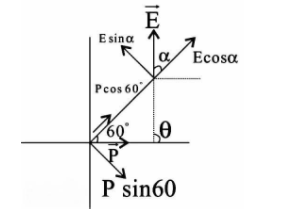
The electric dipole is placed along the x-axis at the origin OF. A point P is at a distance of
A.
B.
C.
D.
Answer
140.4k+ views
1 likes
Hint: Resolve the electrical dipole and electric field in two components. Then find the electric field due to the dipole at the axial and equatorial point.
The electric field due to a dipole at an axial point is given by
The electric field due to a dipole at an equatorial point is given by
Here,
.
Complete step by step answer
Let us first discuss an electric dipole. It is basically an electrostatic system of two equal and opposite point charges separated by a very small distance.
As given in the question that the electric dipole is placed along the x-axis at the origin O and a point P is at a distance of
A diagram is given which shows the case.
Let
Now, the electric dipole and the electric field vector are resolved into the two components.
We know that the electric field due to a dipole at an axial point is given by
For the axial point, the dipole moment has value
Therefore, according to the above expression we have

We also know that the electric field due to a dipole at an equatorial point is given by
For the equatorial point, the dipole moment has value
Therefore, according to the above expression we have
Now, dividing equation (ii) by (i) we have
On simplifying we have
Now, from the figure we have
On substituting the value of
Hence, option D is correct.
Note: The formula used for the electric field due to a dipole in this question is only valid when the distance between the charges of the dipole is very small as compared to the distance between the centre of the dipole and the point where the electric field is to be calculated.
The electric field due to a dipole at an axial point is given by
The electric field due to a dipole at an equatorial point is given by
Here,
.
Complete step by step answer
Let us first discuss an electric dipole. It is basically an electrostatic system of two equal and opposite point charges separated by a very small distance.
As given in the question that the electric dipole is placed along the x-axis at the origin O and a point P is at a distance of
A diagram is given which shows the case.
Let
Now, the electric dipole and the electric field vector are resolved into the two components.
We know that the electric field due to a dipole at an axial point is given by
For the axial point, the dipole moment has value
Therefore, according to the above expression we have

We also know that the electric field due to a dipole at an equatorial point is given by
For the equatorial point, the dipole moment has value
Therefore, according to the above expression we have
Now, dividing equation (ii) by (i) we have
On simplifying we have
Now, from the figure we have
On substituting the value of
Hence, option D is correct.
Note: The formula used for the electric field due to a dipole in this question is only valid when the distance between the charges of the dipole is very small as compared to the distance between the centre of the dipole and the point where the electric field is to be calculated.
Recently Updated Pages
Young's Double Slit Experiment Step by Step Derivation

Difference Between Circuit Switching and Packet Switching

Difference Between Mass and Weight

JEE Main Participating Colleges 2024 - A Complete List of Top Colleges

JEE Main Maths Paper Pattern 2025 – Marking, Sections & Tips

Sign up for JEE Main 2025 Live Classes - Vedantu

Trending doubts
JEE Main 2025 Session 2: Application Form (Out), Exam Dates (Released), Eligibility, & More

JEE Main 2025: Derivation of Equation of Trajectory in Physics

A point charge + 20mu C is at a distance 6cm directly class 12 physics JEE_Main

JEE Main Exam Marking Scheme: Detailed Breakdown of Marks and Negative Marking

Learn About Angle Of Deviation In Prism: JEE Main Physics 2025

Electric Field Due to Uniformly Charged Ring for JEE Main 2025 - Formula and Derivation

Other Pages
JEE Advanced Marks vs Ranks 2025: Understanding Category-wise Qualifying Marks and Previous Year Cut-offs

JEE Main 2025: Conversion of Galvanometer Into Ammeter And Voltmeter in Physics

Degree of Dissociation and Its Formula With Solved Example for JEE

Electric field due to uniformly charged sphere class 12 physics JEE_Main

Dual Nature of Radiation and Matter Class 12 Notes: CBSE Physics Chapter 11

Formula for number of images formed by two plane mirrors class 12 physics JEE_Main




